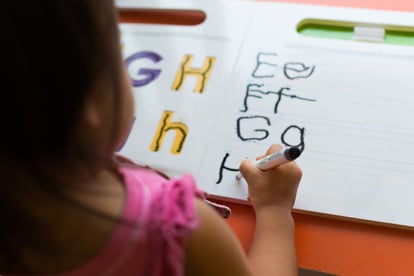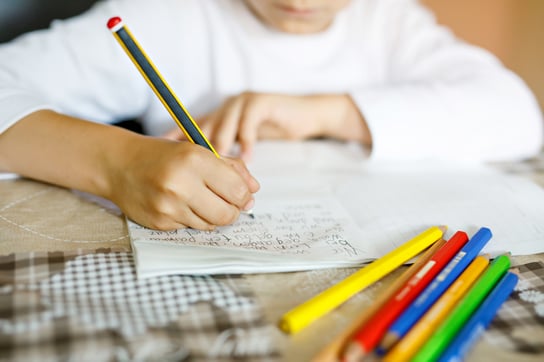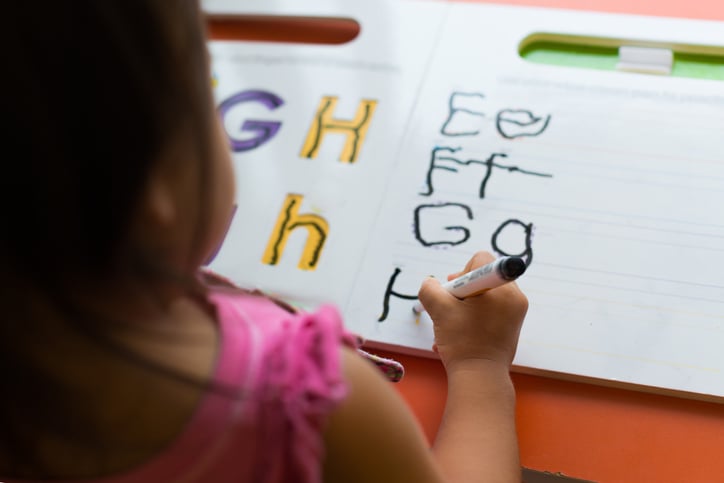Teaching Autistic Children Writing Skills
Learning to write is an important skill. For autistic children, writing provides an outlet for them to express themselves, be creative, and communicate. Learning to write is considered essential for being successful in life. There are certain strategies for teaching autistic children to write that are especially effective.
Why Writing Skills Are Important
Many autistic children experience fine and gross motor skill challenges. Developing writing skills can be difficult. It is important to practice these skills with your child because writing is a form of communication. Learning to write lets children use their imagination, express themselves, record ideas and memories, and connect with others.
Teach Autistic Children Writing Skills
There are steps to learning writing skills. The first is to trace letters, then to copy them, then to write them with a starting point cue, and finally to write them independently. Depending on what your child already knows and their experience using writing utensils, they may need more practice during some steps compared to others.
Tracing:
First, children should practice tracing letters. Choose a pen, crayon, pencil, or marker for your child to write with.
 Procedure:
Procedure:
- Sit at a table with your child. Make sure you have their attention.
- Write a letter. (Use letters the child may be familiar with to start. For example, the letter that their name starts with).
- Model tracing the letter.
- Give the instruction, “Trace the letter [A].”
- Prompt as needed. If your child is just beginning to trace letters, they may need more physical prompting/assistance to hold their pencil and trace the letter.
Tracing letters will help your child begin to identify letters. When your child is ready, have them practice tracing more than one letter, introducing one letter at a time. Work towards having your child trace their full name or a favorite word (e.g. the name of a favorite toy or television show).
Independent Letter Writing
After children become comfortable with tracing letters, the next step is to independently write letters. Using lined or graphing paper can help guide your child’s letters.
Procedure:
- Sit at a table with your child. Make sure you have their attention.
- Give the instruction, “Write the letter [A].”
- Prompt as needed. Especially as your child begins to write letters independently, they may make simple mistakes (e.g. writing the letter backward).
- Reinforce as necessary.
As your child continues to write letters independently, practice writing more than one letter, introducing one letter at a time. Work towards having your child write their full name.
Writing Full Words
Once your child can independently write letters, practice writing full words (e.g. their names, names of family and friends, sight words, favorite words). Your child will be motivated to write about their loved ones and favorite things.
Start with “fill in the blank.” Choose a word such as, “Mom.” Omit a letter so your child can become familiar with the concept (e.g. “M_m”).
Procedure:
 Sit at a table with your child. Make sure you have their attention.
Sit at a table with your child. Make sure you have their attention. - Place fill-in-the-blank words in front of your child with a corresponding picture card.
- Give the instructions, “Fill in the letter(s).,” “What letter goes here?,” or “Write the letter that goes here.”
- Prompt as needed.
As your child continues to make progress in writing, encourage them to practice writing on their own or for fun. Write about a fun day out, what they like to do, a favorite television show, or about their best friend.
Strategies for Teaching Autistic Children
-
Choose the right writing utensil
Pencils, pens, and markers all come in different sizes and weights. If your child is just learning to use a pencil or marker, choose a larger size with a heavier weight. Using a pencil grip may help your child, too. -
Choose the right paper
A blank sheet of white printer paper may appear overwhelming for a child who is just learning to write letters. Support their writing style, letter sizing, and spacing with lined paper, graphing paper, or creating the lines/boxes on a paper that will support your writer. -
Use wrist weights
For many autistic children, keeping their arms and hands still and calm while writing can be difficult. Light wrist weights are worn like a bracelet and can provide additional stability. -
Use graphic organizers
Sitting down and writing can be a daunting task. Help your child organize their thoughts and identify what they would like to write about using a graphic organizer that fits their needs. For example, if they want to write about their family, help them brainstorm all the words that come to mind when they think of their family. -
Model writing
If your child is experiencing writer’s block or demonstrating frustration with writing, join them! Write down some words that will motivate them. For example, writing words that are related to their favorite television show may spark excitement and eagerness to trace the words that you include or write their own. -
Get creative to increase engagement
Writing with pencil and paper isn't always motivating. Writing can be done using many methods! Grab some shaving cream and use your fingers to write in the shaving cream. Use puffy paint or watercolors to practice letters. Incorporate crafting letters with pipe cleaners, clay, or Lego bricks.
Learning to form letters and write to express oneself can be a long process. Have patience with your child and explore different ways that they can communicate and create letters, words, and messages! Choose motivating words and subjects to engage your child.

This article is based on the following research and online resources:
The ARIS curriculum: Reading and Writing Readiness Lessons and Manual
https://the-art-of-autism.com/autism-and-writing-how-to-teach-your-child-to-write/
https://www.time4learning.com/homeschooling/special-needs/autism/writing-strategies.html





